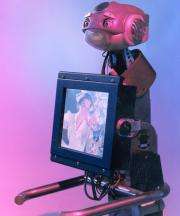Robots help surgeons transcend human limits

At times, it's tough going for Whitney Hatchett. "I was born with three heart defects. Two were operated on when I was 11 days old," she tells us.
That was the first of many surgeries for the 34-year-old. But none was quite like last year's. "It was either to use the robot and have three small scars on my back or if it was done conventionally, I would have a scar all the way around," she explains.
The robot Hatchett refers to is called a da Vinci, which her cardiothoracic surgeon, Dr. David Yuh, explains was the best option for her surgery.
"What we wanted to do is provide her with an operation that posed the least impact to her physically," says Yuh.
To see a da Vinci in action might be a little intimidating at first. But in the simplest terms, it's really virtual reality crossing paths with surgery. The da Vinci Surgical System has two main components. On top of the operating table is a device that has four arms. It looks like a giant insect that hovers right on top of the patient. Those arms are inserted into the patient through small incisions.
Across the room, the surgeon sits near an ergonomically correct stereoscopic viewer. The surgeon, while sitting comfortably, can view a magnified 3-D high-resolution image of the operative site. The surgeon puts his hands in levers and as his hands move the levers, those levers translate his movements into precise movements by the arms of the robot. The surgeon "sees" and can "feel" movement and force of things like cutting and stitching as he watches it in 3-D.
"It allows us to do the kind of intricate maneuvers within her chest that would otherwise require a large incision," explains Yuh.
When he's not in surgery, you might find Yuh honing his skills on the da Vinci at the Engineering Research Center for Computer-Integrated Surgical Systems and Technology (ERC CISST) at Johns Hopkins University in Baltimore, Md. Support from the National Science Foundation (NSF) has kept the center on the cutting edge in the development of surgical robotic technology.
"We're trying to couple the capabilities of machines with the judgment of humans to do a job better," says Russ Taylor, the center's director. "We have the opportunity to work at the cutting edge of technology in direct partnership with physicians that have real problems."
Surgeons like Yuh come here to take the robots out for a test spin. He's using the heart of a dead pig to try out a new video overlay that will serve as a measuring tool. "The video overlay is very helpful. We can actually see what we are measuring right at the time of the operation and it's something that we are looking forward to trying," he explains.
The da Vinci isn't the only robot getting worked on here. Just down the hall, eye surgeon Jim Handa is testing out a steady-hand robot, crucial for eye surgery because it cancels out the threat of human-hand tremors. "The robot can smooth out the movement and enable someone who's not able to do it, to do it quite easily," says Handa.
The robot comes complete with a 3-D monitor. So, with a pair of glasses similar to those worn at 3-D movies, Handa can get a three-dimensional view of just what he is instructing the robot to do. He scrapes the back of a mock eyeball, about the size of a ping-pong ball, ever so carefully with the help of the robot. Handa believes that the accuracy of robotic surgery might advance treatments for conditions like cancerous tumors in the eye. "The future, I believe, is very exciting. It's going to open up a whole different paradigm of how we do surgery."
Center director Taylor agrees and adds, "We can transcend human limits. We can enable a clinician to do things that cannot be done, and we can improve the consistency, accuracy, the safety of existing interventions."
And that has made all the difference for people like Whitney Hatchett.

















